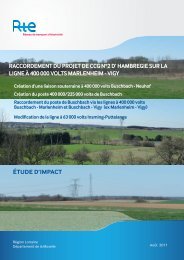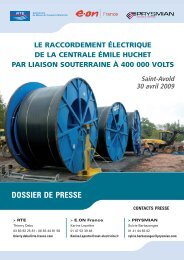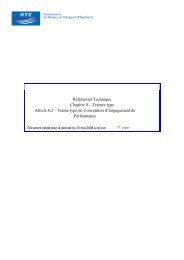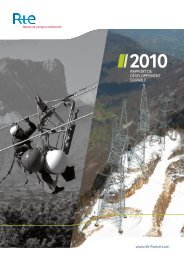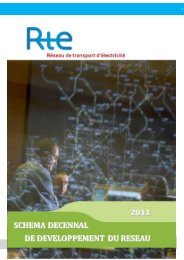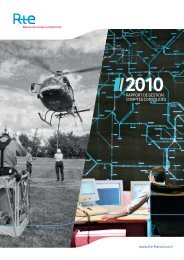R-AUDIT-SG-DAR-MAS-11-2011/022010 <strong>Reliability</strong> <strong>Report</strong>Page : 6/408 juillet 2011protection scheduling of outage; failure to execute a safeguard order by a transmission control centre,with limited impact.The evolution of ESS 0 reveals an increase in the number of problems involving busbar switchdisconnector in 400 kV substations, knowing that incomplete operation can lead to major risks for thereliability of the electrical system. It is necessary to ensure that the current actions are continued andthat they are relevant.The passage of windstorm Xynthia confirmed observations made in 2009 during the passage ofwindstorm Klaus, that the resistance of the network managed by <strong>RTE</strong> is satisfactory.During the flooding, on June 15 th , in the Var, the 225 and 63 kV Trans substations were severelydamaged while the more recent 400 kV substation was not impacted, which is consistent with therequirements established for its construction. The efficient management of the crisis must beunderscored as must the rapid definition of corrective actions.F- Progress actions<strong>RTE</strong> initiates or contributes to many progress actions aiming at reinforcing reliability. These actionsare increasingly being carried out within ENTSO-E. Hence, ENTSO-E continued to work on a unifiedreal-time warning system "ENTSO-E Awareness <strong>System</strong>" for all the TSOs in the association. Itsusefulness and functions were established in light of the lessons stemming from the European incidentof November 4 th 2006. An invitation to tender was launched in 2010 for this project.In 2010, ENTSO-E published its first ten-year European network development plan. In the long term,the economic and environmental performance and the reliability of the electrical system will beimpacted if the associated structures are not actually built, and ENTSO-E has called for a shortening ofthe corresponding permit procedure times.<strong>RTE</strong> organized a joint simulator training session with the Italian TSO TERNA for operators of bothTSOs, and prepared similar types of actions with the Spanish TSO REE. Exchange meetings betweenstaff at an operating level took place with the Swiss TSO Swissgrid, the Belgian TSO Elia and CORESO.<strong>RTE</strong> played a driving role in the actions undertaken to develop European R&D among TSOs. They ledto the definition of a R&D programme for TSOs and DSOs, which was ratified during the first meetingof the “Grid Initiative”, and then ENTSO-E established its R&D work programme for the years 2010-2018.Among the operational R&D actions, <strong>RTE</strong> is participating in several European projects such asTWENTIES (technical feasibility of direct current networks -DC-), PEGASE (models of large grids) andSafeWind, and has also performed studies to cope with the main reliability issues.New technologies are being tested (new low expansion cables to increase flow capacity) or are beingintroduced on the grid (DC line between France and Spain of the voltage source converter type, atechnology that has proven reliability benefits compared with the previous one).G- Management, control and audits<strong>RTE</strong> management has committed the company to a “industrial project for sustainable performance”with different components linked to controlling reliability. In parallel, the company‟s overall internalcontrol system is being developed, with each Unit identifying risks and the associated control actions.The <strong>Reliability</strong> Audit Mission carries out regular in-depth audits. Three audits were performed in 2010on the following topics: digital I&C in substations, operation of interconnection lines, networkrestoration following a generalized blackout. A flash audit was performed following malfunctionsobserved after the removal of a busbar differential protection in a 400 kV substation.Copyright <strong>RTE</strong>. This document is the property of <strong>RTE</strong>. Any communication, reproduction, publication even partial is forbidden without the express written authorisationElectricity Transmission <strong>System</strong> operator (<strong>RTE</strong>)
R-AUDIT-SG-DAR-MAS-11-2011/022010 <strong>Reliability</strong> <strong>Report</strong>Page : 7/408 juillet 2011In summary,From an operation standpoint, 2010 was marked by tense situations during cold spells that <strong>RTE</strong> wasable to manage effectively, but which required issuing safeguard orders more than 15 times. Thesedifficult situations, which reoccur from year to year despite regular improvements made in thereinforcement of compensation means and operational management, reveal structural weaknesses inthe location of generation facilities in the West and South-East regions, as well as the impact of thegrowing thermosensitivity of consumption.<strong>RTE</strong>‟s ability to handle severe meteorological incidents, as already proven in previous years, wasconfirmed during the management of windstorm Xynthia and the flooding in the Var on June 15 th .The incidents that affected electrical system reliability assessed in terms of ESS with a level A orhigher, had increased significantly in 2009. 2010 is characterized by a return to the average trendfrom 2005-2008, even though the number of ESS level A and B remains higher, due to the increase inESS A recorded during tense operating situations during cold spells. Vigilance with regard to reliabilityremains a timely issue and hence <strong>RTE</strong> must keep up its efforts to fully exploit feedback and todisseminate its lessons, even though, in a longer term perspective, we can underscore that thenumber of ESS level B and higher recorded since 2004 is significantly lower that at the start of theprevious decade.Some points of potential risk stand out in this reliability report: the difficulty in making headway in thereduction of occurrences and the consequences of human errors, some of which may be important interms of reliability; the potential vulnerability of operations to data errors and the control of regularlyadapted parameters; the persistence of lasting reactive production capacity limits affecting a certainnumber of units, even though in-depth discussions with the concerned producer made it possible inearly 2011 to define a progressive management process to return to contractual capacities in the nextfew years.As a counterpoint, significant evolutions were made to improve reliability and regularly improvingoperating and control modalities, adapting them to an ever-changing environment: the revision of thefundamental rule of reliability – the N-k; introducing a new method to determine overload temporarycurrent levels to release additional operating capacities; noteworthy improvements in day ahead studymethods, in particular for very tense situations; reinforcement of events feedback.Given these evolutions, we must also ensure that operational teams have enough time to fullyassimilate the changes, especially since the tools themselves are also changing.Finally, like in 2009, progress was once again made in coordination at a European scale, including theincreasingly important role taken on by CORESO in operational management and the evolution incalculation methods of capacities available to the markets, in the framework of the implementation ofday-ahead market coupling in the Europe Centre-West region.********************************************************************Copyright <strong>RTE</strong>. This document is the property of <strong>RTE</strong>. Any communication, reproduction, publication even partial is forbidden without the express written authorisationElectricity Transmission <strong>System</strong> operator (<strong>RTE</strong>)




